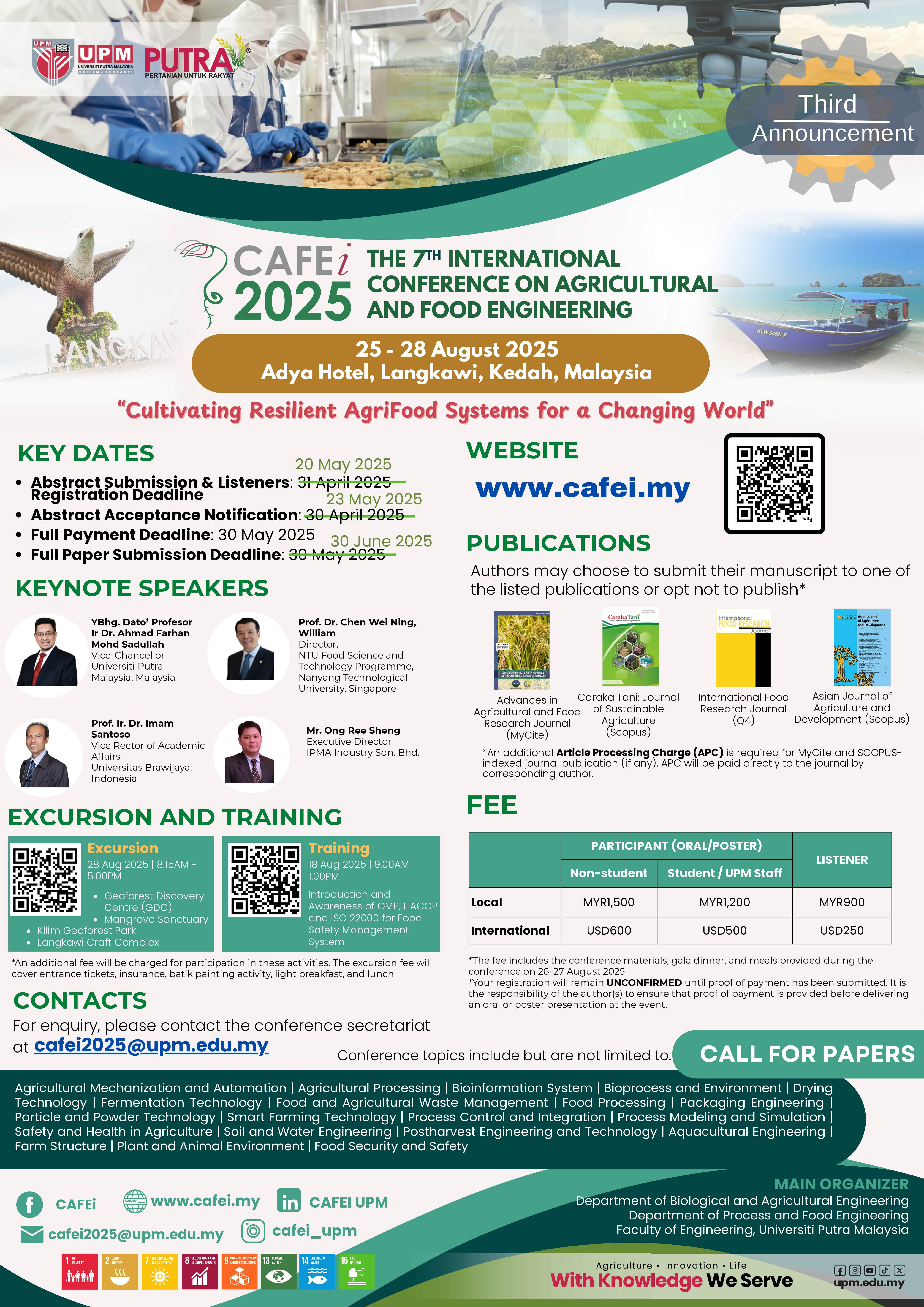Isolation of nanocellulose from Saba’ (Musa acuminata x balbisiana) banana peel by one-pot oxidation-hydrolysis system
DOI:
https://doi.org/10.36877/aafrj.a0000096.Abstract
In the present study, facile one-pot production of nanocellulose from ripe and unripe Saba’ banana (Musa acuminata x balbisiana) peel was conducted by utilizing hydrogen peroxide (H2O2) as an oxidizing agent prior to hydrolysis with sulfuric acid (H2SO4) at different concentrations (8%, 24% and 40%). Proximate and chemical compositions of the ripe and unripe banana peel (BP) powder were analyzed, followed by physicochemical characterizations of the resulting nanocellulose by using Scanning Electron Microscopy (SEM), Fourier Transform Infrared (FTIR) spectroscopy and Dynamic Light Scattering (DLS). FTIR analysis has confirmed the successful removal of non-cellulosic components from the BP through the distinguishable spectra of both the ripe and unripe BP powder with the H2O2/H2SO4- treated samples. SEM analysis revealed morphological changes of the BP powder from an irregular structure with a presence of starch granules to lamellar and fibrous structures after the H2O2/H2SO4 treatment and freeze-drying. The size of the nanocellulose is strongly influenced by the concentration of sulfuric acid used. Nanocellulose from ripe BP produced by using the 40% H2SO4 has the smallest size with D50 < 80 nm. These findings suggest the potential of banana peel, an abundant agricultural waste to be valorized into value-added materials with significant economic potentials.References
Camacho, M., Ureña, Y. R. C., Lopretti, M., et al. (2017). Synthesis and characterization of nanocrystalline cellulose derived from Pineapple peel residues. Journal of Renewable Materials, 5(3–4), 271–279. https://doi.org/10.7569/JRM.2017.634117
Chen, Y. W. (2017). Isolation and Characterization of Nanocrystalline Cellulose From Oil Palm Biomass Via Transition Metal Salt Catalyzed Hydrolysis Process. Retrieved from http://studentsrepo.um.edu.my/7710/6/Thesis_(Chen_You_Wei%2C_HGA_140012).pdf
Chen, Y. W., Hasanulbasori, M. A., Chiat, P. F., et al. (2019). Pyrus pyrifolia fruit peel as sustainable source for spherical and porous network based nanocellulose synthesis via one-pot hydrolysis system. International Journal of Biological Macromolecules, 123, 1305–1319. https://doi.org/10.1016/j.ijbiomac.2018.10.013
Chen, Y. W., Tan, T. H., Lee, H. V., et al. (2017). Self-assembling behavior of cellulose nanoparticles during freeze-drying: Effect of suspension concentration, particle size, crystal structure, and surface charge. Biomacromolecules, 14(5), 1529–1540. https://doi.org/10.1021/bm4001734
Emaga, H. T., Andrianaivo, R. H., Wathelet, B., et al. (2007). Effects of the stage of maturation and varieties on the chemical composition of banana and plantain peels. Food Chemistry, 103(2), 590–600.
Global Market Insights, Inc. (2019).
https://www.gminsights.com/pressrelease/nanocellulose-market
Han, J., Zhou, C., Wu, Y., et al. (2013). Self-assembling behavior of cellulose nanoparticles during freeze-drying: Effect of suspension concentration, particle size, crystal structure, and surface charge. Biomacromolecules, 14(5), 1529–1540. https://doi.org/10.1021/bm4001734
Harini, K., Ramya, K., & Sukumar, M. (2018). Extraction of nano cellulose fibers from the banana peel and bract for production of acetyl and lauroyl cellulose. Carbohydrate Polymers, 201(June), 329–339. https://doi.org/10.1016/j.carbpol.2018.08.081
Khawas, P., & Deka, S. C. (2016). Comparative Nutritional, Functional, Morphological, and Diffractogram Study on Culinary Banana (Musa ABB) Peel at Various Stages of Development. International Journal of Food Properties, 19(12), 2832–2853.
Lavoine, N., & Bergström, L. (2017). Nanocellulose-based foams and aerogels: Processing, properties, and applications. Journal of Materials Chemistry A, 5(31), 16105–16117. https://doi.org/10.1039/c7ta02807e
Leung, A. C. W., Hrapovic, S., Lam, E., Liu, Y., et al. (2011). Characteristics and properties of carboxylated cellulose nanocrystals prepared from a novel one-step procedure. Small, 7(3), 302–305. https://doi.org/10.1002/smll.201001715
Maciel, M. M. Á. D., Benini, K. C. C. de C., Voorwald, H. J. C., et al. (2019). Obtainment and characterization of nanocellulose from an unwoven industrial textile cotton waste: Effect of acid hydrolysis conditions. International Journal of Biological Macromolecules, 126, 496–506. https://doi.org/10.1016/j.ijbiomac.2018.12.202
Malladi, R., Nagalakshmaiah, M., Robert, M., et al. (2018). Importance of agriculture and industrial waste in the field of nano cellulose and its recent industrial developments: A review. ACS Sustainable Chemistry & Engineering, 6 (3), 2807-2828. https://doi.org/10.1021/acssuschemeng.7b03437
Moreno, G., Ramirez, K., Esquivel, M., et al. (2018). Isolation and characterization of nanocellulose obtained from industrial crop waste resources by using mild acid hydrolysis. Journal of Renewable Materials, 6(4), 362–369. https://doi.org/10.7569/JRM.2017.634167
Mukwaya, V., Yu, W., Asad, R. A. M., et al. (2017). An environmentally friendly method for the isolation of cellulose nano fibrils from banana rachis fibers. Textile Research Journal, 87(1), 81–90. https://doi.org/10.1177/0040517515622155
Ramli, S., Ismail, N., Alkarkhi, A. F. M., et al. (2010). The use of principal component and cluster analysis to differentiate banana peel flours based on their starch and dietary fibre components. Tropical Life Sciences Research, 21(1), 91–100.
Shanmugarajah, B., Kiew, P. L., Chew, I. M. L., et al. (2015). Isolation of Nanocrystalline Cellulose (NCC) from palm oil empty fruit bunch (EFB): Preliminary result on FTIR and DLS analysis. Chemical Engineering Transactions, 45(October), 1705–1710. https://doi.org/10.3303/CET1545285
Tibolla, H., Pelissari, F. M., Martins, J. T., et al. (2018). Cellulose nanofibers produced from banana peel by chemical and mechanical treatments: Characterization and cytotoxicity assessment. Food Hydrocolloids, 75, 192–201.
Tibolla, H, Pelissari, F. M., Martins, J. T., et al. (2018). Food Hydrocolloids Cellulose nano fibers produced from banana peel by chemical and mechanical treatments: Characterization and cytotoxicity assessment. Food Hydrocolloids, 75, 192–201. https://doi.org/10.1016/j.foodhyd.2017.08.027
Tibolla, H., Pelissari, F. M., & Menegalli, F. C. (2014). Cellulose nanofibers produced from banana peel by chemical and enzymatic treatment. LWT - Food Science and Technology, 59(2P2), 1311–1318. https://doi.org/10.1016/j.lwt.2014.04.011
Tibolla, H., Pelissari, F. M., Rodrigues, M. I., et al. (2017). Cellulose nanofibers produced from banana peel by enzymatic treatment: Study of process conditions. Industrial Crops and Products, 95, 664–674. https://doi.org/10.1016/j.indcrop.2016.11.035
Downloads
Published
How to Cite
Issue
Section
License
Copyright (c) 2020 Suryani Saallah

This work is licensed under a Creative Commons Attribution-NonCommercial 4.0 International License.
Author(s) shall retain the copyright of their work and grant the Journal/Publisher right for the first publication with the work simultaneously licensed under:
Creative Commons Attribution-NonCommercial 4.0 International (CC BY-NC 4.0). This license allows for the copying, distribution and transmission of the work, provided the correct attribution of the original creator is stated. Adaptation and remixing are also permitted.

This broad license intends to facilitate free access to, as well as the unrestricted reuse of, original works of all types for non-commercial purposes.
The author(s) permits HH Publisher to publish this article that has not been submitted elsewhere.

.png)

.jpg)



